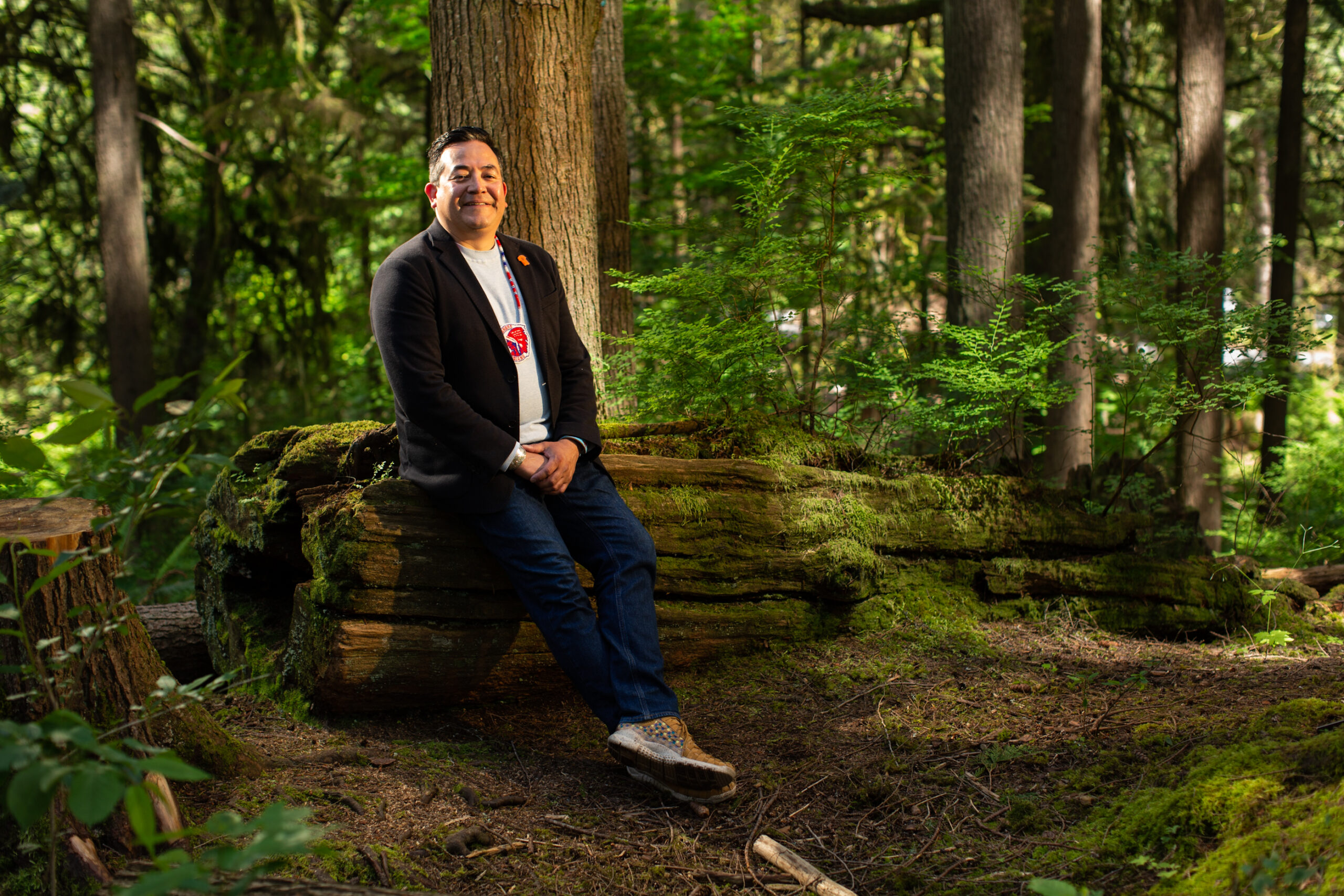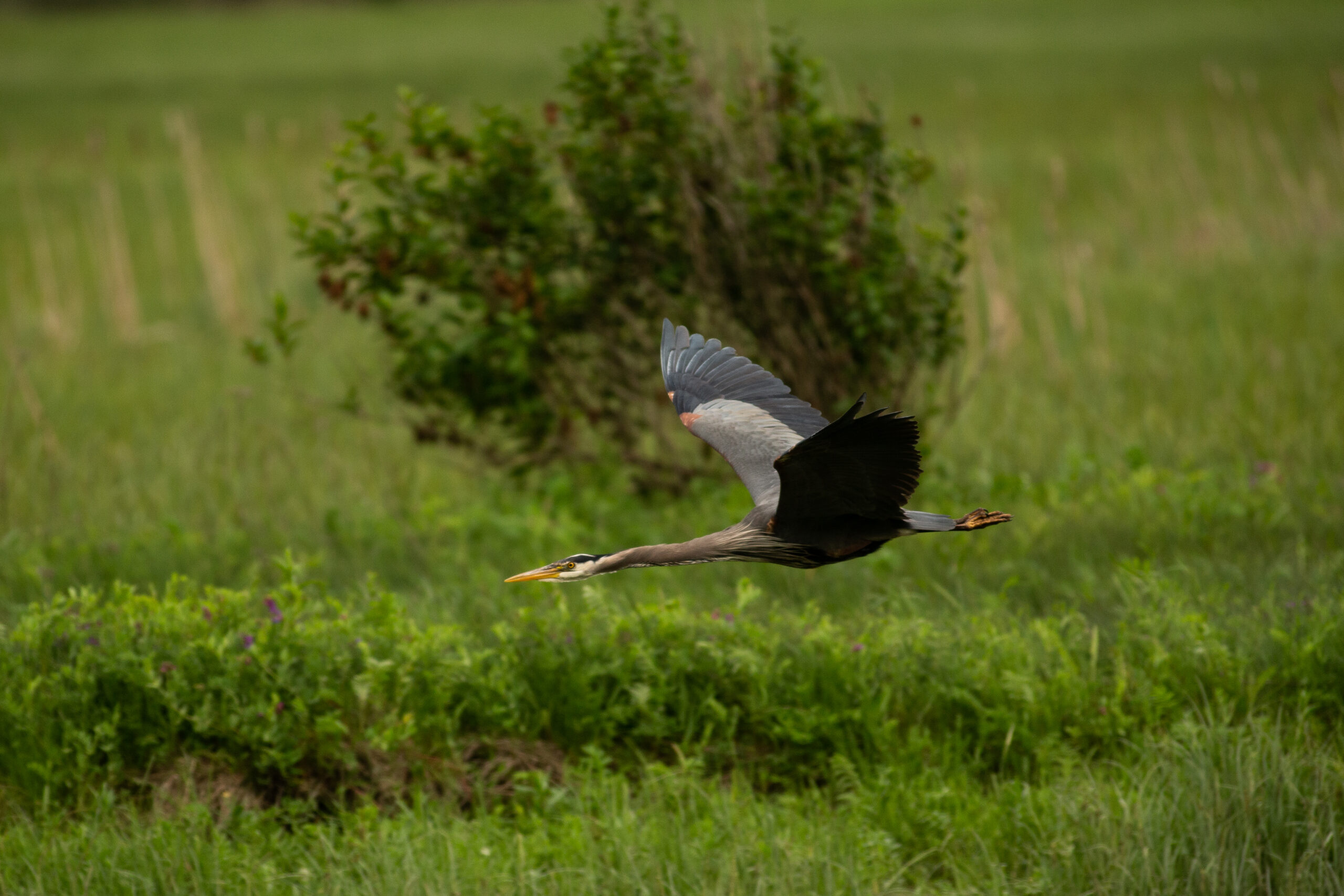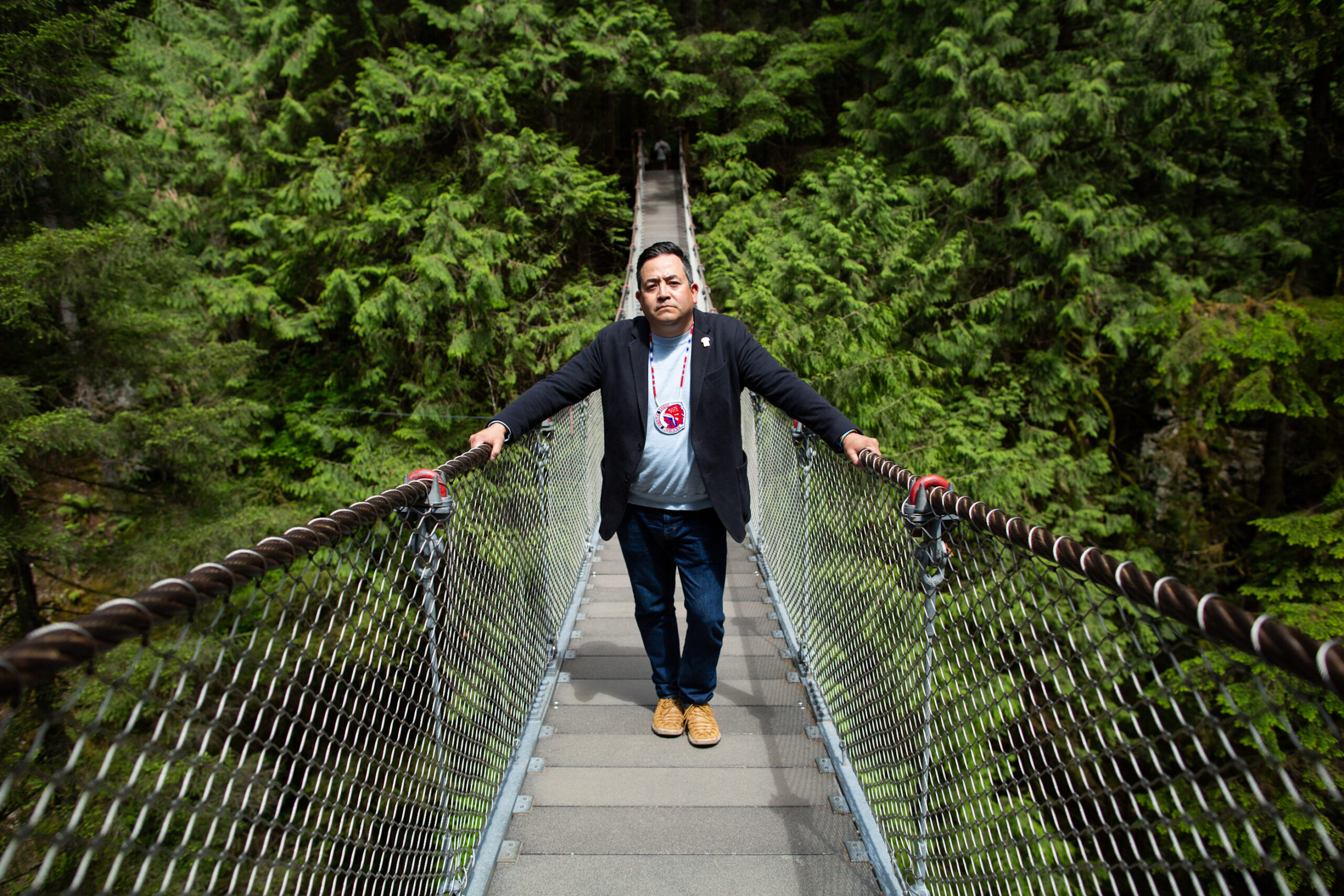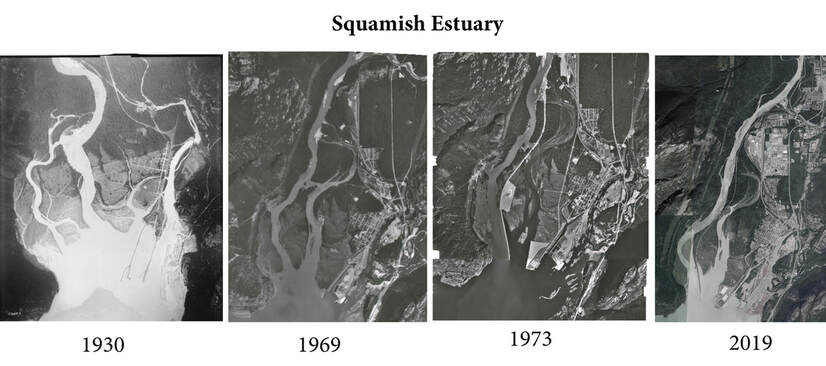This story is part of Going with the Flow, a series that dives into how restoring nature can help with B.C.’s flood problems — and what’s stopping us from doing it.
Just two generations ago, the Squamish estuary — called Skwelwil’em in the Sḵwx̱wú7mesh sníchim (the Squamish language) — remained somewhat peaceful in the face of great change.
The settler village of Squamish was built and growing in the estuary, on the territory of the Sḵwx̱wú7mesh Úxwumixw (Squamish Nation). A railroad was built to Vancouver, and old-growth logging was at its height. Still, amid these colonial disruptions, the estuary was home to salmon, a place for Sḵwx̱wú7mesh to fish and be close to the water of Átl’ḵa7tsem (Howe Sound).
But boundless development and resource extraction continued and the town chipped away at the estuary.
In an example of bulldozing over Indigenous Rights in the name of industry — in the most literal sense — the estuary was dredged in the 1970s by BC Rail for a proposed coal port project without any consultation with the Squamish Nation. A five-kilometre-long spit was built that blocked water and dried up part of the estuary.
The federal government wound up rejecting the proposal — so for about 30 years a massive pile of dredged soil remained abandoned right on top of Skwelwíl̓em. A portion of the estuary, once filled with lush grasses and calm water, was left barren and brown for decades and salmon numbers began to decrease.
Now, the Squamish Nation is co-leading an effort to restore the estuary with the Squamish River Watershed Society and Fisheries and Oceans Canada in a coalition called Restore the Shore, which seeks to “save this vital ecosystem and right historical wrongs.”
This year, the group took on its biggest task yet: removing a fifth of the spit that has blocked juvenile salmon exiting the river from accessing the estuary. The project has been years in the making and has brought together at-times disparate community interests.

Removing the spit “opens the lungs of the river,” Sxwíxwtn (pronounced S—WAY-wah-tin), whose English name is Wilson Williams, told The Narwhal from his office where he serves as a councillor and spokesperson for the Sḵwx̱wú7mesh Úxwumixw.
“It brings back the natural being of it.”
Sxwíxwtn’s name comes from the Squamish village Yekw’ápsem, which means “located in the Squamish Valley along the Squamish River,” he said. His uncle Sxwíxwtn was the last person to carry this name during the 1850s, until he received it in 2019.

“Names are verb-based, not noun-based,” he explains. “Squamish names are directly tied to our land. They describe the territory, what happens there.”
“When one receives an ancestral name they continue to learn, and protect the sacred nature of the name — but more importantly, protect who we are as Squamish Peoples and our culture, traditions, legends and language.”
How Squamish’s community broke down barriers to bring back salmon
The District of Squamish is among the fastest growing communities in B.C., with the population doubling since the early ’90s. All of those extra people living around the estuary has meant navigating multiple competing interests, balancing the desires of newcomers with the rights of the First People and the need to save salmon from extinction while bringing Skwelwil’em back to life.
There’s the Squamish Nation, which has inherent rights to the estuary and intrinsic relationship with salmon. Then there’s the Restore the Shore coalition, which has a goal of improving salmon health. Then you’ve got city businesses, like Squamish terminals, which transports cargo, and is concerned about changes in sedimentation spit removal might bring about. And then there are the residents who comprise that booming population, many of whom are drawn here for the outdoor recreation opportunities. While the spit was disastrous for salmon, it was a boon for kiteboarders, providing an exceptional launch point.
After years of planning, engaging with the public and getting permits, Restore the Shore finally broke open the barrier this year. Between January and April, they dismantled 300 metres of the spit. The coalition, funded by the Coastal Restoration Fund, Pacific Salmon Foundation, Habitat Conservation Trust Fund and the Fish and Wildlife Compensation Program, is currently monitoring for environmental impacts, with plans to remove another 550 metres in October.

The hope is that easier access to safe waters will enhance juvenile salmon’s health and well-being.
Because of the spit, salmon have been “shot out into the ocean before they’re ready,” Patricia Heintzman, spokesperson for the Squamish River Watershed Society, told The Narwhal.
“What they need to do is spend three or four months in the estuary where they saltify, they get strong, their scales get more resilient and there’s a buffet of nutritional things for them.”



Like many fish populations in B.C., salmon populations in the Squamish River have declined in recent years, especially Chinúkw (Chinook salmon). According to Fisheries and Oceans Canada (previously the Department of Fisheries and Oceans), between 1962 and 1972 more than 17,000 Chinook salmon returned to the Squamish River each year on average. By the 1980s, they counted below 500 Chinook. After decades of restoration the watershed society said annual returns have increased to 5,000 Chinook. Wilson said fishermen in the estuary tell him they still don’t see many fish.
Restoration work began back in 1999, with the Squamish Nation partnering with the Squamish River Watershed Society and the Department of Fisheries and Oceans to restore the estuary, in the beginnings of the Restore the Shore initiative.


First, they had to tackle the dredge pile, restoring about 15 hectares of estuary that had been buried — equivalent to about 28 football fields. They restored and constructed tidal channels, replanted vegetation like eelgrass, and constructed pedestrian bridges. In 2007, the estuary was designated as Skwelwil’em Squamish Estuary Wildlife Management Area under the Provincial Wildlife Act. Then, the biggest hurdle: removing at least a portion of the spit.
Salmon are top of mind in all this work — but since Chinook have a four-year life cycle, the community will have to wait that long to truly see what impact the spit removal had on this generation.
Squamish estuary provides over $12 million in ecosystem services every year: report
Estuaries are calm bodies of water where the freshwater of a river flows into a body of saltwater, and are highly productive ecosystems known for their biodiversity. Skwelwil’em supports steelhead trout, herring and five species of sts’u’kwi7, or salmon. Those salmon are sustenance for other animals in the estuary, like eagles and bears, as well as southern resident killer whales and humpbacks.
But estuaries aren’t just good for animals. The Squamish Nation partially funded a 2021 study that found the estuary provides $12.6 million every year in ecosystem goods and services, such as water filtration and flood mitigation. The report emphasized the findings were not exhaustive and didn’t quantify cultural value, since there is no adequate way to put a monetary value on culture.
The study was commissioned by the Squamish River Watershed Society and researched by an independent contractor, Elise Pullar. It builds off of a 2015 study commissioned by the David Suzuki Foundation, which concluded the Howe Sound watersheds provide somewhere between $800 million and $4.7 billion in ecosystem services.
“[The report] is really meant to be a conversation starter,” opposed to providing definitive answers, Heintzman said.
She said she sees the limitations and even the dangers in quantifying nature in a “materialistic” way. But if no attempt at valuation is made, then land can be essentially viewed as “worthless” economically, she argued.
“If we don’t start reevaluating or understanding the value of [nature] in its completeness, then we’re in danger of compromising the future,” she said.

To Sxwíxwtn, the report furthers what “the Squamish people have always known.”
“The land and water must be protected and respected. We must work in step with our lands and waters,” he said.
“If we don’t take care of the natural world, it won’t take care of us.”
The cultural component is important as Squamish people reclaim their connection to that part of the territory, councillor Joyce Williams wrote in an opinion piece in 2021.
“As our lands heal and are revitalized, so is our culture and connection to it,” she wrote. “This connection will continue to strengthen once again with continued and improved recognition of the importance of estuaries for the community as a whole.”
From disagreement to understanding
Sxwíxwtn said the work to remove the spit has been a “great initiative” and there has been “mutual respect” between all the partners, in a stark contrast to how the spit was built without any consultation with the Squamish Nation.
“If proper consultation had occurred … there would have been a stronger vision in regards to protecting the natural habitat and resources. In this case, our salmon life cycles,” Sxwíxwtn said.
“They need to hear our voice.”
But this work has also come with challenges. For windsport enthusiasts, the Squamish Spit was a world-class launching point and some felt this wasn’t being adequately considered in the removal process. A petition from 2020 signed by nearly 3,000 people described the spit as a premiere kiteboarding location and a place where professional athletes and Olympians train. Restore the Shore proposed leaving an island at the end of the spit to be used as a launch point, but the windsports society pushed for some kind of road access to be built.
When Restore the Shore received approval to remove the spit in January, leaving an island for kiteboarders to use, the president of the windsports society, Sean Millington, told The Narwhal their membership was “not happy” because they were still unsure if their access to the water would be inhibited.
But the Squamish Windsports Society has ultimately arrived at a place where they support the Nation and its efforts to bring back salmon, and want to move ahead in partnership.

For the first time this summer, kiteboarders tried a new system of boating to what they’re calling Spit Island. Its members pitched in to buy a boat for the society. After a summer of accessing Spit Island by boat, Millington said members have been pleasantly surprised to see it’s not as difficult to get to the island as expected. He said people were more worried when it was all “theoretical,” but are reassured now that they see an “actual solution in place.”
“The feedback that I’m getting from most people when I talk to them is, ‘This actually went pretty well. It wasn’t as bad as I thought it might be,’ ” he said. “The feedback has been mostly positive.”
A five-time Canadian Football League all-star, and two-time Grey Cup Champion, Millington is someone whose life has been devoted to athletics. He has been windsurfing for 20 years, and started kiteboarding in 2017. He became the society’s president in January.
Millington emphasized the society supports the Squamish Nation, and that they signed a memorandum of understanding. He said he knows the future of the estuary isn’t the windsports society’s decision.
“We do believe in the cooperative and understanding relationship that we’ve managed to arrive at, even if there have been times when our goals and their goals weren’t necessarily lined up,” he explained.

Millington said he learned from the challenge of bringing together “a whole bunch of diverse opinions.”
“It’s really important, in that process, to listen to what everyone is saying and do your best to understand where each of the parties is coming from.”
Despite being situated on Howe Sound, the city residents have very limited access to the water; the shore is mostly dominated by industry. Millington hopes there is still a chance a land bridge will be built to the island to make access easier — but he’d only want to see a land bridge with the approval of the Squamish Nation.
“We fully back the Nation,” he said.
To Edith Tobe, executive director of the Squamish River Watershed Society, collaboration is the story, she argued emphatically.
Tobe said overcoming challenges and disagreements required patience and building trust.
“It’s been very interesting to me, because it is a community where there are a lot of disparate interests,” she said. “And there’s room for everybody.”


Sxwíxwtn said the Nation has worked closely with the windsports society and other stakeholders. Open dialogue will remain important as the coalition continues working to restore the estuary, he added.
“I’m a firm believer in building a strong relationship, first and foremost, as a foundation,” he said. “That will bring us to that mutual understanding.”
Sxwíxwtn said this is an important moment for the Nation to be making decisions on their own territory and bring knowledge to the table.
“We’re in the room now to share what we can respectfully, and share the stories. We have strong legends and they all connect to the waterways, the mountains, the animals. And they always come back to survival, perseverance and strength.”
‘We can’t engineer our way out of problems’
The Squamish River naturally oscillates back and forth, but that movement was halted by the spit, and the river stopped depositing as much sediment to the estuary.
Tidal marshes naturally accumulate sediment and vegetation, which can slow down water, decrease wave height and attenuate wave energy, biologist Eric Balke, coordinator of the south coast conservation land management program with Ducks Unlimited, told The Narwhal. If you cut off the estuary from its sediment source, you have “inhibited the capacity” of that ecosystem, he said. In the face of sea level rise, that means tidal marshes could disappear.
“If we lose a lot of these tidal ecosystems that protect us from sea level rise, then that potentially will make us even more vulnerable to flooding,” he said.

Balke believes that more research is needed, but theoretically, allowing more water and sediment flow to the estuary should support its resilience.
“The realignment of the spit may, over the long term, actually help protect the community from sea level rise,” he said.
Heintzman hopes restoring the estuary will encourage people to consider nature-based climate solutions, which means empowering the natural processes of nature to mitigate the impacts of climate change. For example, the estuary can act as a “big sponge” and absorb water to protect the coastline from storm surge, coastal flooding and sea level rise, she said.

Nature-based climate solutions include protecting and enhancing forests, wetlands and grasslands that sequester a lot of carbon.
“We can’t engineer our way out of problems,” she said. “[Engineered solutions] are very, very expensive and they don’t fulfill the very complex and multifaceted role that nature does.”
An estuary can provide the same flood protection as a dike while also providing food, habitat, tourism and carbon sequestration while filtering air and water, she said.
“It provides all this value added,” she said.
The report commissioned by the Squamish River Watershed Society recommends that the district of Squamish develop a natural asset management framework and prioritize nature-based solutions over engineered solutions to climate risks. It also suggests the district establish the estuary as a carbon sink on the carbon market.
In an emailed statement, the district’s mayor Karen Elliott said work is underway to develop a natural asset management strategy and the district already prioritizes restoring natural assets over engineered assets “where possible.”
As for pursuing the possibility of earning carbon credits from the estuary, Elliott only said the district is paying attention to the carbon credit market and “watching closely.” She said no existing methodologies would support claiming carbon credits for conserving the estuary.
“Any credits would be a result of re-establishing wetland or salt marsh areas, or conserving areas that are at risk of development,” she said.

Elliott emphasized the difficult nature of putting monetary value on nature and said the district has not verified the methodologies used in the watershed society’s report to assign specific dollar values to the estuary.
“We do, however, recognize the importance of recognizing and protecting our natural assets,” she added.
For Sxwíxwtn, it comes back to the culture and relationships that place can foster. When he was a young child, his father regularly brought him down to the Sḵwx̱wú7mesh Staḵw (Squamish River) to fish. That peaceful time by the river with his father is a time he cherishes. Now that his father is older, he provides fish to his father, just like his father did for him when he was a child. He wants to ensure Chinook and other salmon across the territory are healthy for future generations.
“Our ancestors and our past leadership set us up for a strong future,” Sxwíxwtn said. “Our people are always at the forefront.”


